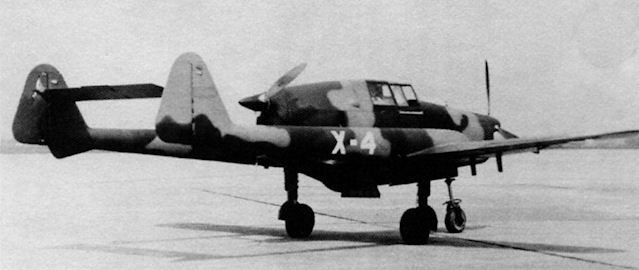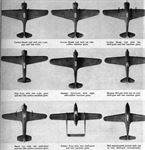
Описание
Страна : Нидерланды
Год : 1939
Единственный экземпляр
Одноместный истребитель
D.XXIII
Fokker D.XXIII
Прототип истребителя Fokker D.XXIII, появившийся в 1939 году, вызвал интерес у авиационных специалистов во всем мире во многом благодаря своей необычной компоновке. Его разработчиком был инженер Мариус Билинг. Он разместил в оконечностях цельнометаллической гондолы фюзеляжа два двигателя с тянущим и толкающим винтами. Между ними в закрытой кабине размещался пилот. К низкорасположенному свободнонесущему крылу деревянной конструкции крепились две балки с килями и рулями направления; кили были соединены горизонтальным оперением. Использовалось полностью убирающееся шасси с носовым колесом.
Силовая установка самолета состояла из двух маломощных двигателей жидкостного охлаждения Walter Sagitta I-SR. "Fokker" надеялась получить заказ от правительства Голландии и, возможно, от зарубежных покупателей. Учитывая не очень впечатляющие характеристики, продемонстрированные прототипом, рассматривалась возможность установки на него двигателей Rolls-Royce или Daimler-Benz. Учитывая высказанные опасения о безопасности пилота, который в случае покидания самолета мог бы попасть под хвостовой винт, Билинг начал проектировать катапультное кресло, но здесь его постигла неудача.
Первый полет D.XXIII состоялся 30 мая 1939 года, и он выявил недостаточное охлаждение заднего двигателя. Поэтому до момента германского вторжения в Нидерланды прототип успел налетать всего несколько часов. После оккупации Голландии никаких данных о дальнейшей судьбе D.XXIII нет.
ТАКТИКО-ТЕХНИЧЕСКИЕ ХАРАКТЕРИСТИКИ
Fokker D.XXIII
Тип: одноместный истребитель
Силовая установка: два 12-цилиндровых V-образных двигателя Walter Sagitta I-SR мощностью по 530 л. с. (395 кВт)
Летные характеристики (проектные): макс. скорость 525 км/ч; потолок 9000 м; дальность полета 840 км
Масса: пустого снаряженного 2180 кг; максимальная взлетная 2950 кг
Размеры: размах крыла 11,50 м; длина 10,20 м; высота 3,80 м; площадь крыла 18,50 м!
Описание:
- D.XXIII
- Flight, December 1938
The Paris Aero Show
Фотографии
-
Мировая Авиация 135
Fokker D.XXIII являлся интересной попыткой решить проблему с асимметрией тяги при отказе одного из двух двигателей, но мощность силовой установки прототипа оказалась недостаточной. Кроме того, при покидании машины с парашютом пилот рисковал попасть под удар заднего винта.
-
Flight 1939-07 / Flight
FOKKER DEVELOPMENTS: The tandem-engined Fokker D.23 single-seater fighter is now doing its initial test flights. The prototype has Walter Sagittas, but the much more powerful Rolls-Royce Merlins or Daimler-Benz 601s may later be fitted.
-
Flight 1938-12 / Flight
A view showing the layout of Fokker’s new D.23 single-seater twin-engined fighter, powered with two Walter Sagitta inverted vees.
-
Flight 1939-06 / Flight
DUTCH PROTOTYPE: The Fokker D.23 single-seater twin-engined fighter (inverted vee-twelve air-cooled Walter Sagittas) photographed shortly after its first flight. This machine was exhibited at the last Paris Salon and may be regarded as the prototype of aircraft with two Rolls-Royce Merlins or Daimler Benz D.B. 601s. It is designed for one shell-gun and two large-bore machine guns firing explosive bullets.
-
Air International 1980-04 / Fighter A to Z
The unusual D XXIII of centreline-thrust concept
-
Flight 1938-12 / Flight
The unorthodox Fokker D.23 single-seater fighter has unusual ammunition feed arrangements for its Browning guns, designed to economise space.
-
Flight 1938-12 / Flight Advertisements
A NEW DEPARTURE IN PURSUIT AIRCRAFT FOKKER D.23: HIGH-SPEED TWIN-ENGINED SINGLE SEAT FIGHTER
-
Flight 1940-03 / Flight
The Flight drawing depicts the Fokker D.23 single-seater twin-engined fighter which, fitted with Isotta Fraschini Delta engines, is claimed to have a top speed of 342 m.p.h. More powerful engines are visualised. The airscrews rotate in opposite directions, compensating torque and gyroscopic form.
-
Flight 1938-12 / Flight
The cooling air for the rear Walter Sagitta on the Fokker D.23 is admitted through this scoop.
-
Flight 1938-12 / Flight
The nose wheel of the Fokker D.23 tricycle undercarriage showing that when retracted it occupies a good deal of fuselage space.
-
Flight 1938-12 / Flight
A neat stabiliser on the tricycle undercarriage leg of the Fokker D.23, to check wheel shimmy
-
Flight 1939-12 / Flight
Armament of Single-seaters: Curtiss Hawk 75A with one 0.3in gun and one 0.5 in.; Curtiss Hawk 75A with six rifle-calibre machine gun; Curtiss Hawk 75A with two shell-guns and two machine guns; Fiat G.50 with two 0.5in. guns and two rifle-calibre machine guns; Hawker Hurricane with eight rifle-calibre machine guns; Morane M.S.406 with one 20 mm. shell-gun and two machine guns; Bloch 151 with two shell-guns and two rifle-calibre machine guns; Fokker D.23 with two shell-guns and two machine guns; Bell experimental pursuit with one 37 mm. shell-gun (unconfirmed).
Другие самолёты на фотографии: Bell P-39 Airacobra - США - 1939Bloch MB.150/151/152/155C1 - Франция - 1937Curtiss Hawk 75 / P-36 / Mohawk - США - 1935FIAT G.50 Freccia - Италия - 1937Hawker Hurricane - Великобритания - 1935Morane-Saulnier MS.405/406/410C1 - Франция - 1935
-
Air Enthusiast 2001-09 / F.Gerdessen - Fokker's 'Paper' Fighters
Fokker Ont.156, dated December 23, 1937.
- Фотографии














